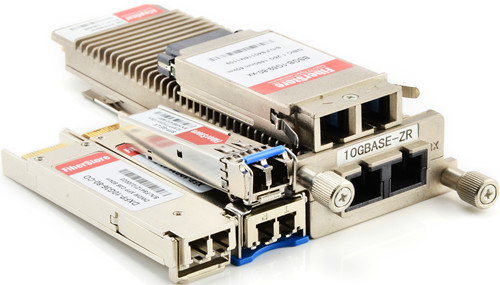With the technological advancements and improvements made in fiber optic communication, service providers nowadays are more inclined to choose fiber optic to achieve high-level data transmission. Fiber optics generally offer users higher bandwidth, more reliable data transfer and better overall performance, thus to enable a smooth and excellent communicating experience. Fiber optic transceiver, which is considered to be the core of optoelectronic device in the WAN, MAN or LAN infrastructure, plays an indispensable part in fiber optic networks for data communication and Ethernet applications. This article is intended to explain how fiber optic transceivers are classified according to different standards and principles, such as fiber mode, transfer rate and connector type.
Fiber Optic Transceiver Overview
First of all, let’s take a quick glimpse of what fiber optic transceiver is and how fiber optic transceiver works.

Fiber optic transceivers combine a fiber optic transmitter and a fiber optic receiver in a single module. They are arranged in parallel so that they can operate independently of each other. Both the receiver and the transmitter have their own circuitry and can handle transmissions in both directions. In fiber optic data links, the transmitter converts an electrical signal into an optical signal, which is coupled with a connector and transmitted through a fiber optic cable. The light from the end of the cable is coupled to a receiver, where a detector converts the light signal back into electrical signal. Either a light emitting diode (LED) or a laser diode is used as the light source.
Common Classification Methods
The classification of fiber optic transceiver falls into various categories based on their performance characteristics and end-use. Classified by characteristics, they often include: fiber mode, transfer rate and connector type.
Fiber Mode
Fiber mode is the most fundamental classification of fiber optic transceivers, here the “mode” refers to the type of fiber intended to be used with a transceiver. The two primary types of fiber mode types are single-mode fiber and multimode fiber.
Multimode fibers allow multiple modes of light to couple into the fiber. Since multimode applications are always short reach, very inexpensive transmitters and receivers are typically used in multimode transceivers. As shown in the table below, there are several popular types of multimode fibers in use today. OM1 and OM2 fibers are appropriate for low speed transmission, such as 100 Mbps to 1 Gbps, which often utilize LED transmitters. OM3 and OM4 are referred to as laser-optimized multimode fibers, as lasers are used as optical sources at 10Gbps and faster.
| Fiber Classification | Core Diameter (microns) | Bandwidth* Length Product (MHz*km) |
| OM1 | 6.25 | 160-200 |
| OM2 | 50 | 400-500 |
| OM3 | 50 | 2000 |
| OM4 | 50 | 4700 |
Single-mode fibers, however, only allow a single mode of light to couple into the core. The most common type of single-mode fiber is termed “OS1” by the ITU and is also known as “standard single-mode fiber”. So most optical transceivers are simply specified for operation over OS1.
Transfer Rate
Fiber optic transceiver modules also can be categorized by their data transfer rates. There are five popular rate categories used in fiber optic transceiver classification: 100GBase, 40GBase, 10GBase, 1000Base and 100Base. These rates refer to the speed at which a fiber optic transceiver is able to transmit data over Ethernet.
- 100GBase—100 Gigabits per second (100GE, 100GbE, 100Gbps)
- 40GBase—40 Gigabits per second (40GE, 40GbE, 40Gbps)
- 10GBase—10 Gigabits per second (10GE, 10GbE, 10Gbps)
- 1000Base—1 Gigabit per second (1GE, 1GbE, 1Gbps, 1000Mbps)
- 100Base—100 Megabits per second (Fast Ethernet, FE, 100Mbps)
Connector type
Optical fiber connectors couple and align transceivers so that light can pass through the core. Based on their connector types,transceiver modules can be classified into different groups. There are four main types of fiber optic connectors used in conjunction with optical transceivers: SC, LC, MPO, and ST.
| Connector | Description | Form Factors Using |
| SC | Subscriber Connector (snap-in connector) | GBIC, X2, XENPAK, some QSFP (40G) and CFP (100G) |
| LC | Lucent Connector (small form-factor version of the SC connector) | SFP, SFP+, XFP |
| MPO | Multi-fiber Push-On (commonly 12 or 24 fibers per) | Some QSFP (40G) and CFP (100G) |
| ST | Straight Tip Connector (bayonet mount connector) | Not used on optical transceivers but popular at optical patch panels |
Connector types generally follow a color code system. If a boot is used over the connector, then a blue boot symbolizes compatibility with single-mode fiber and a beige boot symbolizes compatibility with multimode fiber.
Conclusion
When you desire for fiber optic transceivers to achieve fiber optic link in your networking applications, the classifications listed above may provide you a guideline to select the most appropriate optical transceiver. Which will contribute to improving your network performance and reliability. Fiberstore offers a great amount of fiber optical transceivers which are fully compatible with major brands in the current market. For more information and details, you can visit www.fs.com.

No comments:
Post a Comment